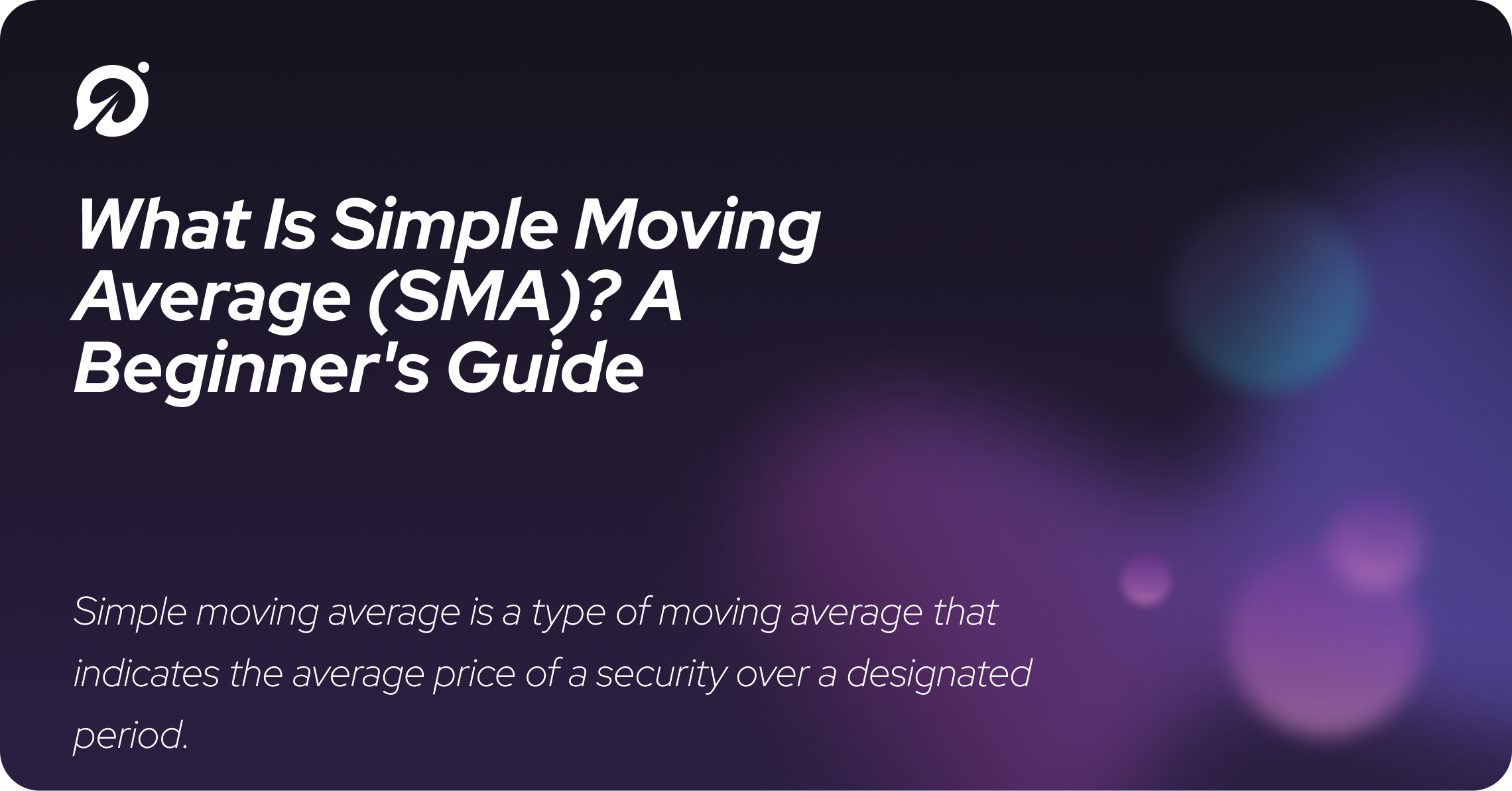What Is Simple Moving Average (SMA)? A Beginner's Guide
A simple moving average (SMA) is a stock indicator used to calculate the average of a specific range of prices over an extended period. In finance, SMA follows trends and patterns of stocks and other securities. Read on to learn more about how SMA is used and works.

Disclaimer: This is for informational purposes and is not meant to serve as financial or investing advice.
What Are Moving Averages?
Moving averages or moving average indicators visualize the average price movements of a financial instrument over a specific period, most commonly closing prices. There are a few different types of moving averages, and each differs in how specified data points are signified or weighted.
These averages are called “moving” because the stock price constantly changes, so the moving average changes accordingly.
For example, a short-term moving average of a 10-day SMA (simple moving average) would average the closing prices for the first 10 days from the first data point. On day 11, the first data point becomes day 2, where the average is recalculated on a rolling basis.
Likewise, a long-term moving average of 100-day SMA would work similarly, calculating the closing price average.
Along with a simple moving average, SMA for short, other types of moving averages are exponential moving averages, EMA, and weighted moving averages, WMA.
What Is Simple Moving Average (SMA)?
A simple moving average (SMA) is a technical indicator. It is an unweighted moving average that calculates the average of a range of prices by the number of periods within that range. An unweighted moving average means that it consists of equal weight.
As a technical indicator, SMA can assist in determining if an asset price will continue on average on an uptrend or reverse in a downtrend.
SMA aids in smoothing out volatility and makes it easier to identify price trends of a designated security.
It is important to note that short-term averages respond quickly to changes in underlying asset prices, while long-term averages are slower to react.
What Is the SMA Used For?
SMA has analytical significance and is used to track popular trading patterns in stock trading.
What Is the Analytical Significance of SMA?
The SMA indicator is the most accessible moving average to follow and is mainly used to determine trend direction. If the SMA is moving up, the trend is moving upward. If the SMA is moving down, the trend is moving downward.
Regarding averages, you can use SMA to smooth over price data and other technical indicators. The longer the period of SMA, the smoother the average result, but more lag is to be expected.
Another way to use SMA to determine trends is by comparing moving averages covering different time periods. You can find an upward trend when a short-term SMA exceeds a long-term SMA. Vice versa, you can determine a downward trend if a long-term SMA is above a short-term SMA.
Which Popular Trading Patterns Utilize SMA?
Two popular trading patterns utilize SMA: the death cross and the golden cross.
A death cross occurs when the 50-day SMA crosses below the 200-day SMA. This is then considered a bearish signal, or in other words, losses.
A golden cross occurs when a short-term SMA crosses above a long-term SMA, which indicates high trading volume and can signal a bullish signal, meaning more profits.
How Do You Calculate the SMA?
To calculate the simple moving average, add recent closing price points over a designated period, then divide the total by the number of time periods.
What Is the SMA Formula?
SMA formula is
SMA = Added total of prices of time periodTotal number of periods
Example: 5-day SMA with closing price points of 10, 20, 30, 40, 50.
SMA= 10 + 20 + 30 + 40 + 50 = 1505 =1505 = 30 SMA
What Are Some Trading Strategies Using SMA?
1. Trading on SMA intersections
Traders commonly use SMA to time their buy and sell trades. To do this, they determine when the stock price line intersects with the SMA line.
By looking at a stock graph, you can observe when the price surpasses the SMA line to indicate an uptrend; this indicates a good buy time. Vice versa in downtrends. Downtrends are an indicator that it’s time to sell.
2. SMA Crossover Strategy
Another common SMA technical strategy for entering and closing trades is SMA crossover. To perform this, plot two SMA lines based on two different time frames. Observe when the two lines cross over, which enables traders to better time their trade.
The most popular moving averages for long-term investors are the 50-day SMA and 200-day SMA. For short-term investors, the 10-day and 20-day SMAs are the most popular.
What’s the Difference Between SMA and EMA?
EMA, also known as the exponential moving average, can be considered an enhanced simple moving average more heavily weighted on recent price movements.
Since EMA puts more emphasis on recent data points, it is considered a weighted average calculation.
The significant difference between the two, SMA vs. EMA, is the sensitivity each one shows to the price changes in the data set of its calculation. In general, EMA responds more quickly to price changes than SMA, and EMA will display a higher value when prices rise than SMA and vice versa. EMA will display a rapid decline in value faster than SMA when prices fall.
EMA gives a higher weight to recent price action, while SMA gives an equal weight to all its price values. These two averages are interpreted similarly and used by technical traders to smooth out price fluctuations and volatility.
In most cases, traders prefer EMA over SMA because of its quick response time.
What Are the Advantages of Using SMA?
When looking for the simple moving average of closing prices over a long time frame, SMA will have the advantage of smoothing the average of long-term trends but also causing a lagging indicator.
What Are the Advantages of Using EMA?
An advantage of EMA is that it uses recent data and the most current price actions, which is preferred among many traders. EMA results are more active and timely than SMA results.
What Are the Limitations of SMA?
As mentioned, SMA relies heavily on historical data. A limitation experienced traders find with SMA is that outdated data is less reliable than recent data reflecting currency trend signals like EMA.
Economists believe that markets do not necessarily need to track outdated data; instead, recent data should reflect all the data needed to trade or determine trading strategies. If this is true and markets are efficient enough, historical data should not impact new data or the future direction of financial asset prices.
How Does SMA Work in Technical Analysis?
Traders use simple moving averages and SMAs to map out the long-term trajectory of stocks or securities. They use SMA over a specified period rather than tracking recent stock prices.
Ultimately, this allows traders to determine uptrends or downtrends over more extensive time periods, which can combat stock market volatility.
An example of how SMA is used in technical analysis is if the 100-day SMA of a security or stock falls below its 50-day SMA, this can be analyzed as a bearish death cross pattern and a trading signal of a downtrend.
If this situation occurred vice versa and the 100-day SMA crossover was above the 50-day SMA, this pattern would indicate the golden cross and an uptrend.
Other Examples of Moving Average Indicators
A Bollinger Band technical indicator has bands typically placed two standard deviations from a simple moving average.
When the indicator moves toward the upper band, this suggests that the security is becoming overbought. If the indicator moves toward the lower band, the security is oversold.
In this case, the standard deviation is used as a statistical measure of volatility.
The Bottom Line
As one of the core indicators in technical analysis, SMA has proven to be a reliable indicator of trading trends with low resistance levels.
It is used to combat stock market volatility and analyze historical price data over an extended period. Understanding how SMAs are constructed before using them to help in your trading strategies is essential.
For more information on making informed trading decisions, visit Pluto today!
Sources:
Moving Average (MA): Purpose, Uses, Formula, and Examples | Investopedia
Bollinger Bands®: What They Are, and What They Tell Investors | Investopedia
What is EMA? How to Use Exponential Moving Average With Formula | Investopedia.com
